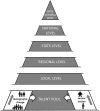Effects of Resistance Training in Youth Athletes on Muscular Fitness and Athletic Performance: A Conceptual Model for Long-Term Athlete Development
- PMID: 27242538
- PMCID: PMC4861005
- DOI: 10.3389/fphys.2016.00164
Effects of Resistance Training in Youth Athletes on Muscular Fitness and Athletic Performance: A Conceptual Model for Long-Term Athlete Development
Abstract
During the stages of long-term athlete development (LTAD), resistance training (RT) is an important means for (i) stimulating athletic development, (ii) tolerating the demands of long-term training and competition, and (iii) inducing long-term health promoting effects that are robust over time and track into adulthood. However, there is a gap in the literature with regards to optimal RT methods during LTAD and how RT is linked to biological age. Thus, the aims of this scoping review were (i) to describe and discuss the effects of RT on muscular fitness and athletic performance in youth athletes, (ii) to introduce a conceptual model on how to appropriately implement different types of RT within LTAD stages, and (iii) to identify research gaps from the existing literature by deducing implications for future research. In general, RT produced small-to-moderate effects on muscular fitness and athletic performance in youth athletes with muscular strength showing the largest improvement. Free weight, complex, and plyometric training appear to be well-suited to improve muscular fitness and athletic performance. In addition, balance training appears to be an important preparatory (facilitating) training program during all stages of LTAD but particularly during the early stages. As youth athletes become more mature, specificity, and intensity of RT methods increase. This scoping review identified research gaps that are summarized in the following and that should be addressed in future studies: (i) to elucidate the influence of gender and biological age on the adaptive potential following RT in youth athletes (especially in females), (ii) to describe RT protocols in more detail (i.e., always report stress and strain-based parameters), and (iii) to examine neuromuscular and tendomuscular adaptations following RT in youth athletes.
Keywords: adolescents; children; muscle power; muscle strength; muscular endurance; physical fitness; weight lifting.
Figures





References
-
- Armstrong N., McManus A. M. (2011). Physiology of elite young male athletes, in The Elite Young Athlete, eds Armstrong N., McManus A. M. (Basel: Karger; ), 1–22. - PubMed
-
- Balyi I., Way R., Higgs C. (2013). Long-Term Athlete Development. Champaign: Human Kinetics.
Publication types
LinkOut - more resources
Full Text Sources
Other Literature Sources
Research Materials
Miscellaneous

